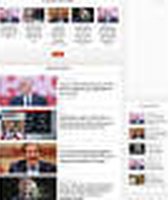Stand up for the facts!
Our only agenda is to publish the truth so you can be an informed participant in democracy.
We need your help.
I would like to contribute
FBI investigators announced July 5 that Hillary Clinton sent or received more than 100 emails over a private server while secretary of state that contained information that was classified when it was sent.
"Although we did not find clear evidence that Sec. Clinton or her colleagues intended to violate laws governing the handling of the classified information, there is evidence that they were extremely careless in their handling of very sensitive, highly classified information," FBI Director James Comey said.
Ultimately, Comey said he will make a recommendation that the Justice Department should not prosecute Clinton, noting there is no precedent for bringing criminal charges in a case like this. But Comey shared findings from the investigation that undermine part of the story Clinton has told for the past year.
Clinton has consistently said she didn’t send or receive anything marked classified at the time they were sent — and the approximately 2,000 emails that the State Department classified before their public release were victim to retroactive classification.
"I never received nor sent any material that was marked classified," Clinton said July 2, after Clinton was interviewed by the FBI as part of its investigation. "And there is a process for the review of material before it is released to the public, and there were decisions made that material should be classified. I do call that retroactively classifying."
Sign up for PolitiFact texts
Clinton’s statements like this left open the question of whether she sent or received classified information that was inappropriately left unlabeled — or that Clinton, as head of the department, failed to recognize and deal with information that should have been classified. Because of that obfuscation, we rated her claim Half True.
We have since re-rated that claim False based on the new information. You can read why here.
But the FBI investigation clearly undercuts Clinton’s defense if she makes a similar claim again.
What the FBI found
The FBI investigation found 110 emails in 52 email chains that contained information that was classified at the time it was sent or received. Eight chains contained top secret information, the highest level of classification, 36 chains contained secret information, and the remaining eight contained confidential information.
Importantly, Comey noted that "a very small number" of these emails contained classification markings, which directly contradicts Clinton’s previous defense. And for the ones that didn’t bear markings, Clinton and her team still should have known the information was not appropriate for an unclassified system.
"There is evidence to support a conclusion that any reasonable person in Sec. Clinton's position or in the position of those with whom she was corresponding about the matters should have known that an unclassified system was no place for that conversation," Comey said of some of the top secret chains.
About 2,000 emails have been retroactively classified, or up-classified, meaning the information was not classified when it was emailed but is now. (There are legitimate issues with the government classification process, which we’ve detailed, here and here.)
Federal agencies can classify information after the fact, for example, if an international situation changes in such a way that would affect the sensitivity of the information. To make matters more complicated, the State Department and the intelligence community disagreed over what was or should have been treated as classified. Government agencies regularly disagree over what should be classified or not, and transparency advocates say the government regularly over-classifies.
Throughout this saga, Clinton has also said she turned over all work-related emails to the State Department in 2014, about 30,000 emails. That is plainly not the case, based on Comey’s statement. He said FBI investigators uncovered "several thousand" work-related emails that she had not handed over to the State Department, and three of those were classified at the time they were sent.
Investigators concluded that there is no evidence to suggest Clinton or her staff deleted these emails in an attempt to conceal them. Rather, Clinton probably deleted emails periodically "like many email users," or her lawyers mistakenly deleted them when sorting work-related emails from personal emails. Clinton has said her staff deleted the personal emails.
"We believe our investigation has been sufficient to give us reasonable confidence there was no intentional misconduct in connection with that sorting effort," he said.
Comey noted, though, that there are likely work-related emails still out there that FBI investigators were unable to find.
"We are pleased that the career officials handling this case have determined that no further action by the department is appropriate," Clinton spokesman Brian Fallon responded in a statement. "As the secretary has long said, it was a mistake to use her personal email and she would not do it again. We are glad that this matter is now resolved."
Our Sources
See individual fact-checks for sources.
















































